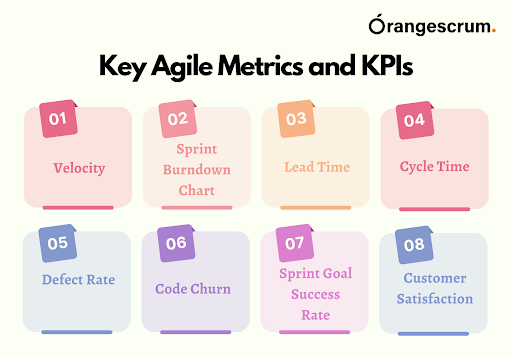Limited Time Offer: Full Feature Access. Plans start @$13 for 11 users Get Started Now
Agile methodologies have transformed the way teams approach project management and product development. Central to the Agile philosophy is the idea of continuous improvement, which relies on data-driven insights to make informed decisions.
Agile Metrics and Key Performance Indicators (KPIs) provide a structured way to measure team performance, identify areas for improvement, and drive success.

Agile Metrics and KPIs serve multiple purposes within an Agile team:
Metrics provide valuable feedback on processes, allowing teams to identify areas that need improvement. This fosters a culture of continuous learning and adaptation.
Metrics offer transparency into the progress of work, helping teams and stakeholders understand the current state of the project or product.
Data-driven decisions are more reliable and lead to better outcomes. Metrics enable teams to make informed choices about priorities, resource allocation, and process adjustments.
KPIs help align team efforts with organizational goals. By tracking performance against predefined metrics, teams ensure they are moving in the right direction.
Velocity measures the amount of work a team can complete within a given iteration or Sprint. It helps in predicting future work and understanding the team's capacity.
This chart illustrates the progress of work within a Sprint. It shows the work remaining each day, helping the team stay on track to meet its Sprint goal.
Lead time measures the time it takes for a task or feature to go from the request stage to completion. It helps teams identify bottlenecks in the workflow.
Cycle time is the duration between starting work on a task and completing it. It provides insights into how quickly the team can deliver value.
Defect rate measures the number of defects or issues identified in a product. A lower defect rate indicates better quality.
Code churn quantifies the amount of code changes within a Sprint. High code churn may indicate instability in the development process.
This KPI assesses the team's ability to achieve the goals set for each Sprint. It provides an indicator of the team's commitment and delivery capability.
Measuring customer satisfaction through surveys or feedback is crucial in Agile. Happy customers are often a sign of successful Agile practices.
To harness the power of Agile Metrics and KPIs for measuring team performance, consider the following best practices:
Choose metrics that align with your team's goals and project objectives. Not all metrics are applicable to every situation, so focus on what matters most.
Ensure that data collection is consistent and accurate. Deviations in data collection can lead to misleading insights.
Metrics should not be used to assign blame. Instead, they should be used to identify areas for improvement and to drive constructive discussions within the team.
Establish baseline measurements to provide context for your metrics. Understanding where you started can help track progress effectively.
Agile Metrics and KPIs are not set in stone. Periodically review and adjust them as the team's needs and objectives evolve.
In the realm of agile software development, the journey doesn't end with the last sprint – it extends into the realm of reflection, adaptation, and growth.
Agile Metrics and KPIs are not just tools for assessment; they are the mirrors reflecting a team's strengths, areas for improvement, and overall health. As we navigate the ever-evolving landscape of project management, let these metrics be our allies in the pursuit of excellence.
By leveraging the insights gained from effective measurement, teams can not only meet but exceed expectations, making each sprint a step forward in the relentless pursuit of perfection. So, measure wisely, adapt proactively, and let Agile Metrics guide your team towards unparalleled success.